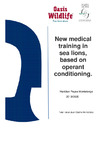Identificador persistente para citar o vincular este elemento:
https://accedacris.ulpgc.es/handle/10553/75519
| Campo DC | Valor | idioma |
|---|---|---|
| dc.contributor.advisor | Castro Hernández, José Juan | es |
| dc.contributor.author | Reyes Montelongo, Haridian | es |
| dc.date.accessioned | 2020-11-13T13:23:09Z | - |
| dc.date.available | 2020-11-13T13:23:09Z | - |
| dc.date.issued | 2020 | - |
| dc.identifier.uri | https://accedacris.ulpgc.es/handle/10553/75519 | - |
| dc.description.abstract | The operant conditioning is a new technique implemented by zoos, as a measure to improve the quality of life of animals in captivity, as well as to have a route of interaction with animals. In this work we have studied the association of new training exercises with the objective of facilitating medical control, using the operant conditioning in four sea lions of Patagonia (Otaria flavescens), in the Oasis Wildlife Fuerteventura (Fuerteventura, Canary Islands). The time required for each individual to perform each exercise has been compared, as well as the necessary repetitions required after the introduction of new elements in the environment. The results indicate that, in an almost general way, the animals show a suspicious behavior before each new exercise, with variations in the approach and learning times depending on the character of each individual. These learning times may be related to the history of previous experiences of each specimen throughout its captivity. The operant conditioning is shown as an effective method of training and seems to be useful to favor and solidify the relationship between coach and animal. In addition to reducing stress levels during captivity. | en_US |
| dc.language | eng | en_US |
| dc.subject | 240118 Mamíferos | en_US |
| dc.subject | 240119 Zoología marina | en_US |
| dc.subject.other | Otaria flavescens | es |
| dc.subject.other | Sea lions | es |
| dc.subject.other | Operant conditioning | es |
| dc.subject.other | Medical training | es |
| dc.title | New medical training in sea lions, based on operant conditioning | es |
| dc.type | info:eu-repo/semantics/bachelorThesis | en_US |
| dc.type | BachelorThesis | en_US |
| dc.contributor.departamento | Biología | es |
| dc.contributor.facultad | Facultad de Ciencias del Mar | en_US |
| dc.investigacion | Ciencias | en_US |
| dc.type2 | Trabajo final de grado | en_US |
| dc.utils.revision | Sí | en_US |
| dc.identifier.matricula | TFT-52071 | es |
| dc.identifier.ulpgc | Sí | en_US |
| dc.contributor.buulpgc | BU-BAS | es |
| dc.contributor.titulacion | Grado en Ciencias del Mar | es |
| item.grantfulltext | restricted | - |
| item.fulltext | Con texto completo | - |
| crisitem.advisor.dept | GIR ECOAQUA: Biodiversidad y Conservación | - |
| crisitem.advisor.dept | IU de Investigación en Acuicultura Sostenible y Ec | - |
| crisitem.advisor.dept | Departamento de Biología | - |
| Colección: | Trabajo final de grado | |
Visitas
276
actualizado el 31-oct-2024
Descargas
45
actualizado el 31-oct-2024
Google ScholarTM
Verifica
Comparte
Exporta metadatos
Los elementos en ULPGC accedaCRIS están protegidos por derechos de autor con todos los derechos reservados, a menos que se indique lo contrario.
